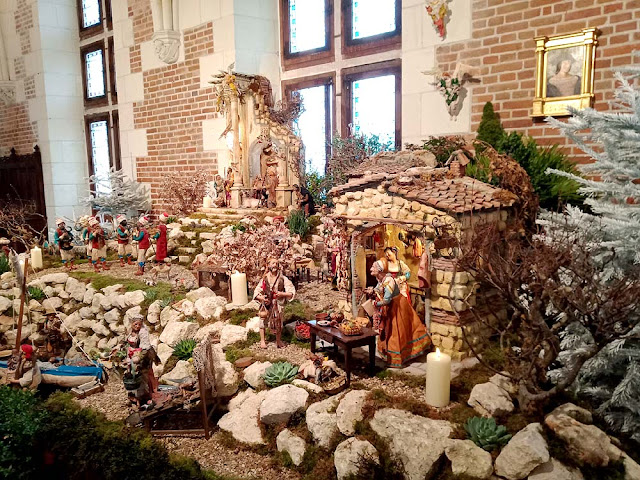The Chateau Royal d'Amboise would have brought its impressive Neapolitan nativity scene out of storage yesterday and they will display it for the whole of December.
Neapolitan nativity figurines are still made and collected today, but their peak was in the second half of the 18th century. Each figure, piece of scenery or accessory may be hand made of several different materials, including glazed terracotta, wood, wire armatures wrapped in fibres, metal, wax and embroidered textiles. Held upright by spikes on their feet pushed into a cork display base the figures are famous for their level of exquisite detail. The Amboise collection reflects the tradition of showing highly detailed scenes of working life around the actual nativity scene. Curiously, it is these foreground trades, merchants and working figures which are really the stars of the show, with the Holy Family receding into insignificance right at the back.
Traditionally the setting up of these nativity scenes begins on 30 November, and is finished by 8 December (apart from adding the figure of the baby Jesus, which is not done until 25 December). The background for the Holy Family is typically a ruined temple in which the stable is housed, with beautiful angels flying above. The peasants are dressed in colourful Neapolitan and Sicilian regional costumes. In the really expensive sets the jewels adorning the Kings and their entourage are real. The 'oriental' band is also a typical feature.
Neapolitan churches have featured nativity scenes at Christmas time since at least the 11th century. At first the figures were made of polychrome painted and carved wood and were life size, stood in front of a painted background. After the 16th century the size had begun to reduce and the background began to be increasingly three dimensional panoramas of the City of Naples. With the 18th century Enlightenment and the Baroque style, the figures were put into secular locations, in wealthy private homes, and an attention to detail and hyper realism became a hallmark.
The Amboise nativity has more than 40 characters and dozens of accessories, all needing to be handled with great care due to their fragility. The collection is augmented every year with a few more pieces, as is traditional. The idea of acquiring a Neapolitan nativity came from the former director ten years ago, and there is evidence that someone in the court of Charles VIII ordered one in the 15th century. Charles VIII laid claim to Naples by virtue of Réné of Anjou leaving his kingdom to Charles's father Louis XI, but quickly lost it at the end of the 15th century.
A similar but somewhat later tradition has grown up around hand made and collectable nativity figures from Provence, known as santons ('little saints').





No comments:
Post a Comment